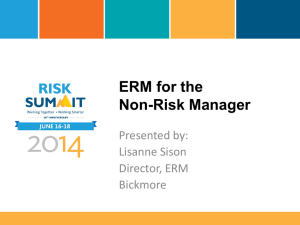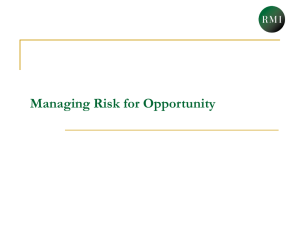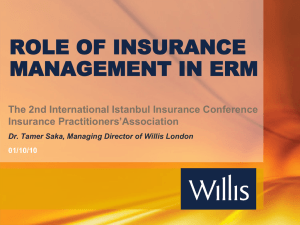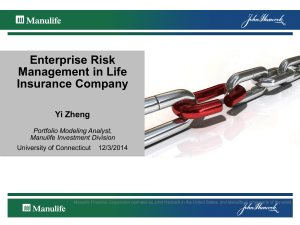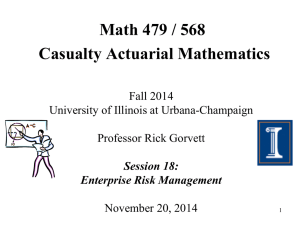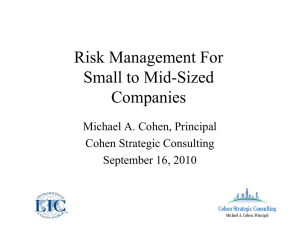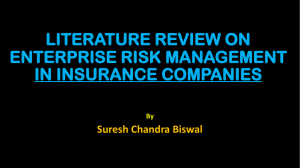ERM100 -- Designing an ERM Infrastructure
advertisement
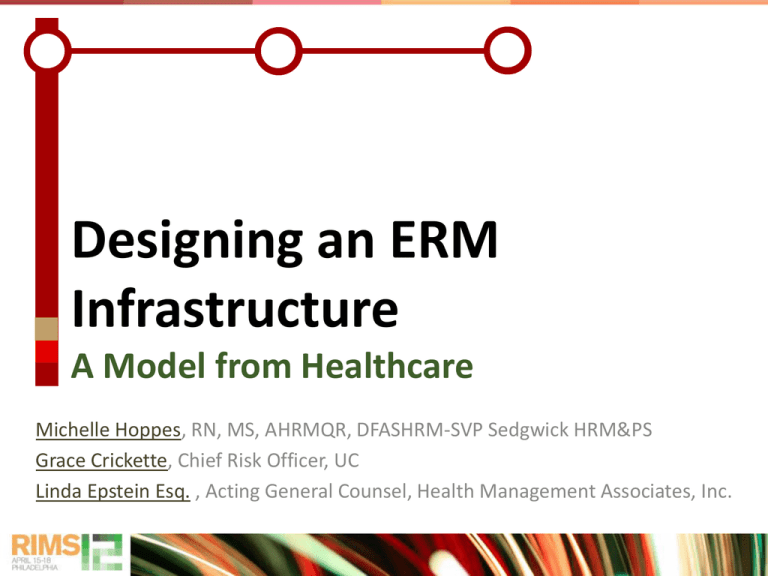
Designing an ERM Infrastructure A Model from Healthcare Michelle Hoppes, RN, MS, AHRMQR, DFASHRM-SVP Sedgwick HRM&PS Grace Crickette, Chief Risk Officer, UC Linda Epstein Esq. , Acting General Counsel, Health Management Associates, Inc. Discussion Items • ERM Program Design – Internal and external review – Identify key risk indicators – Key Components of Successful Programs • Healthcare Case Studies – Focus area—acquisitions and critical event investigation – Tools at the front line-embedding ERM – Overcoming Barriers • Outcomes – Demonstrating Value Protection and Creation 2 ERM Components Uncertainty Management Holistic Approach Value Protection Value Creation 3 ERM Model and Domains Value Protection And Value Creation Holistic Approach Operations Clinical / Patient Safety Strategic Technology Legal / Regulatory Hazard Environment Human Capital Financials ERM 4 Checklist for Successful ERM Process Infrastructure/accountability Robust risk identification Accurate identification of key risk indicators Metrics are actionable Mitigate, manage, monitor Defining risk appetite and risk tolerance/capacity Risk domain owners-accountable Evaluation of internal and emerging risks Early warning systems—no surprises Modeling to forecast risk Measuring TCOR and benefits A process not a program Assess risk culture regularly Support by board and senior management Part of operational culture with process owners and drivers Long term strategic view of risk Customized to your organization ERM at the front level: understanding role in managing risk Risk is considered in all facets of decision making Continually optimize risk strategy Focus on most significant 5 First Steps in ERM Infrastructure Risk Potential • Current • Emerging • Unknown Internal • Assess • Culture • Profile External • Market change • Regulatory • Legal 6 External Market Forces PAST PRESENT FUTURE first do no harm volume based value based never events business intelligence ERM model reform patient safety – national imperative Risk Manager as Decision Facilitator--Leader 7 Volume based Value based second curve first curve Economic Futurist • Aligning hospitals, physicians, and other providers • Utilizing evidence-based practices to improve quality and patient safety • Improving efficiency through productivity and financial management • Developing integrated information systems 8 Reform Implications Transformative awakening Most sweeping change to health care since Medicare was enacted Healthcare Fundamentally alters the healthcare landscape Demand for services will increase astronomically 9 The Demand – The Risk • Boomers aging • 33-40 million more to be insured Patient Protection Act • Shortage of 85,000 to 96,000 doctors by 2020 • Nursing shortage will exceed 800,000 by 2020 Council Grad Med Education Health Resource And Service Admin 10 Economic Futurist Core Organization Competencies Patient Accountablecenteredleadership Patient integration Electronic Protection Act and data for PI collaboration Strategy in unstable environment Engage employees full potential Financial stewardship – Enterprise Risk Management 11 IOM – New Frontiers in Patient Safety “Only serious when on no pay list “ 2001-2009 Central line infections drop 63% Cost of Medicare 91% increase trend next decade Two choices: Spend less or improve care Partnership for Patients CMS Innovation Center 12 Target • $500 million CMS Innovation Center • 40% reduction preventable harm • Hospital engagement contractors • • • • • Adverse drug reactions CAUTI, CLABSI, VAP, VTE, SSI Falls OB adverse events Readmissions 13 Healthcare Top Risks Value based reimbursement - PI Healthcare reform Patient safety and quality HAC prevention Medicare fraud and abuse Pandemic Environmental Professional staff shortages Economy - revenue stress Terrorism IT-EMR 14 Internal Assessment – Broad Categories of Review Financial Loss Prevention Clinical and Patient Safety Legal – Regulatory Acquisitions and Mergers Compliance Hazard – Environment Strategy Reputational Risks Operations Technology ERM Assessment Human Capital 15 Acquisition-Sample Due Diligence Areas Mergers, Acquisitions, Divestitures, Joint Ventures Clinical • Transitions of Financial Human Resources • Stability • Turnover • Bond covenants • Talent retention • Patient safety & recruitment • Debt • Payer Mix • Access to capital acquired conditions-never • Contracts events purchasing • On-call specialists • Supply mgmt • HIPAA • Health Reform • Physician contracts • Hospital • Value based • TJC Technology Strategic Hazard/Operations • EMR-hybrid • Vision • OSHA • Social media • Goal alignment • Fire • Vendor • Competition • Crisis • CMS care and quality outcomes Legal & Regulatory • EPL • Mandatory • Comparable benefit program Reporting • PSO • Unionization • Liabilities • Drug diversion • Insurance • Disruptive behavior • Workers comp • DEA license • Broker of record alignment • Conflict of • CPOE prevention/ management Interest • EOC • Security- information breach • Market potential • Culture fit • Access • Storage tanks • Back up • Data integrity • Managed care ownership 16 Key Documents Material-Documents Target Areas Marketing Advertising Warranties, guarantees Service lines Insurance Coverage by line of exposure Policy type and limits Exclusions Actuarial reports Financial viability PCE’s---all reported Claims –loss runs by: o Specialty o Provider o Indemnity / expense o Trends Satisfaction Areas of excellence Areas of exposure Patients and staff Regulatory Survey, licensure, accreditation and consultants reports Citations Sanctions Property -Locations Inventory Contracts Access / signage Assets Vendors Liabilities 17 Drill Down-Example Risk List Technology Risks • EMR process/stage • IT alignment •Connectivity • Breach- access •Information access Financial Risks • Payor / reimbursement cuts •Expense ratio •Rating agency •Revenue cycle •Bonds •Tail coverages •Claims—all lines •Benefit plans Legal / Regulatory Risks •MMSEA compliance •Fraud & abuse •Anti-trust •Privacy & security / HIPAA •EMTALA violations •Compliance program •Legal environment-tort Clinical/Operational Risk •Readmissions •Pressure ulcers •Wrong-site surgery •RFB •SSI •Adverse medication outcomes •Adverse OB outcomes •Falls •Patient centered approach •Pandemic outbreak •Structured communication/handoff •Specialty and service access •Standardized procedures/guidelines •OR availability •Clinical quality scores •Aviation/helipad Human Capital Risks • Union contracts/strikes • Low morale/culture • Fatigue / long shifts • Turnover • Aging • Stability of leadership • Behavior • TalentQuest-retention of key staff Strategic Risks • Negatively publicized event • Partner dependencies • Market share retention/growth • Strategic plan • Ambulatory reach • Profit capture • Internal controls 18 Tour-Assessment and Clinical Safety Profiling 19 High Risk Areas High Risk Area Review and Reduction of Preventable Harm 70% 65% 60% 50% 36% 40% 30% 24% 20% 10% 10% 0% OB Element Compliance ED Overall Category Compliance OR Behavioral Health Linear (Overall Category Compliance) 20 High Risk Clinical Areas-Drill Down ED • Chest pain bundles lacking, wait times excessive • AMA high • Failure to diagnose abdominal pain OR • OR fires • Wrong site surgery-spines • RFB OB • • • • Resuscitation of newborn intubation EFM certification Midwife scope Emergency c/s timeliness and nurse deliveries 21 OB Bundles ELECTIVE INDUCTION AUGMENTATION VACUUM • Gestational age greater than or equal to 39 weeks • Normal fetal status (per NICHD tiers • Pelvic exam prior to the start of Oxytocin • Recognition and management of tachysystole • Documentation of estimated fetal weight • Normal fetal status (per NICHD tiers) • Pelvic exam prior to the start of Oxytocin • Recognition and management of tachysystole • Alternative labor strategies considered • Prepared patient • High probability of success • Maximum application time and number of pop-offs predetermined • Cesarean and resuscitation teams available 22 ERM in a Decentralized Organization Everyone’s a Risk Manager ERM Identify the key risks that will interfere in meeting our Mission Identify risk treatments and leverage the Power of Ten Office of the President sponsors numerous risk treatment initiatives 23 ERM Program: Focus on Tools Example • “No Tech” – Informational Content – Distributed via web/email “Low Tech” • “High Tech” – Information Systems – Cognos based business analytics and optimization – Custom-built information systems Enterprise Risk Management Program Business Processes • “Low Tech” – Partial Automation of Data – Excel based, e.g. risk assessment tool “High Tech” “No Tech” 24 ERMIS Business Architecture 25 ERM at the Event Level Incident Adverse Event Claim / Lawsuit Incident reporting system captures identified event or near miss Adverse event directed to category manager/quality & risk* Directed to local risk manager, claims adjuster, OGC and OPRS Directed to category manager Serious events identified and reviewed by weekly quality of care steering committee Case reviewed by facility risk committee for quality of care issues Trend reports developed by location quality or risk Sentinel event/root cause analysis Corrective action is reported to board of regents as part of request for settlement Metrics & benchmarks Metrics & benchmarks Retrospective reviews/UC action Trend reports provided to location quality & safety committee Trend reports provided to location quality & safety committee Trend reports are forwarded to the location executive committee of the medical staff Trend reports are forwarded to the location executive committee of the medical staff Trend reports provided to governing body Trend reports provided to governing body (includes near misses) 26 Resources for Integration Source: http://www.ucop.edu/riskmgt/erm/bulletins.html 27 UC Action Background • Basic system functionality was originally intended to be a campus specific activity tracking tool • Original tool was repurposed to automate the retrospective review process • Team has made multiple presentations on the proposed functionality of the tool, and incorporated changes and suggestions from campus and medical center risk managers whenever possible Tools for Evaluating Risk 29 Overcoming Barriers ERM is not just about the deliverables!! • Not just a Risk Assessment, or a Strategic Plan, or Mitigation Plan • ERM does not replace what you are already doing but rather leverages these activities and builds on them • ERM is about the thought process-does not replace your professional experience or judgment! Value of ERM • • • • Improved management of risks Improved quality and sustainability of controls Consistent approach and terminology used across the organization Improved visibility and understanding of risk across the entire organization (causality as well as impact) • Makes Everyone a Risk Manager!!! 30 Dashboards A Key Component of ERM Infrastructure High Level and Drill Down Monitoring: Example Key Risk Indicators 32 ERMIS Dashboards Background • • • Users - Risk Managers enterprise wide, enterprise leadership, general counsel’s office, external finance staff, UCSF Police Department personnel, and medical center HR and quality departments Web based BI solution Designed to provide: – – – – – Better quantitative analysis capabilities Improved analytical and reporting capabilities Support for leading risk governance and compliance processes System wide visibility, with local flexibility Scalability without additional burden on UC staff ERMIS Cognos Dashboard Development Priority Pipeline Process Overview Steps 2 3 4 5 6 7 8 9 10 11 12 13 14 15 16 17 18 19 20 21 22 23 Medical Quality Strategic Sourcing Office of General Counsel Travel Incidents, Calls, Claims UC Travel Dashboard Waste Management Workgroup Ergonomics / Remedy Interactive Education Abroad Program (EAP) Construction Contracts & Grants StayWell Location Participation Medical Center PL Cube Rep Risk - (CDPH, OSHA) University of California, Irvine Safety Index + Enhancements Human Capital + Enhancements Budget and Risk Assessment Master Scorecard UC Ready Dashboard Effort Reporting Fine Arts IVOS Process Overview Steps 24 25 26 27 28 29 30 31 32 Dashboard Name UCSF Disability Management NFPA UCSD Scorecards (Target 3/11) UCSD HR UCD MC UC Police Dept (Target 4/11) TM1 – ERMIS / Budget and Plan Health Policy and Services 2 3 Process Step Indicators = Completed 2. KPI Development & Data Availability 6. Prototype Testing = Started 3. Develop Solution Outline (Mock-Up) 7. Design Review and Final Approval = Not Started 6 37 UCI Lab Building Safety Survey UCI Ergonomic -Pelletier, Remedy, 38 Equip Purchase, Costs 39 UCI Actuarial Data 40 UC Ready Enhancements 41 ERMIS Adoption Dashboard 42 Waste Management & Recycling 5. Dashboard Design & Development 5 1. Receive Dashboard Request 4 UCB – AVC 33 Be Smart about Safety 34 OGC Package 35 UCI Safety On Site Prog Metrics 36 UCI LMS Safety Training Records Process Step Descriptions 4. Data Acquisition 1 7 Overcoming Barriers 35 Outcomes Return on Investment (ROI) Key Components Driving Value ERM process- tools include these four components: • Create Efficiency – Benefits that result in saved time, fewer resources, or faster cycle time • Reduce Cost of Risk – Benefits that result in a lower risk exposure, fewer claims, less expensive claims, lower insurance rates or reduced administrative costs • Improve Cost of Borrowing – Benefits that result in improved debt ratings and reduced borrowing rates • Reduce IT and Operational Redundancy – Benefits that allow users to leverage a single tool to support multiple activities, or support a single process system-wide to achieve consistency Create Efficiency Reduce Cost of Risk Improve Cost of Borrowing Reduce IT and Operational Redundancy Example: ERM Benefits in Healthcare First non-financial institution to receive credit agency acknowledgement of ERM program System-wide ERM information system Drive down total cost of risk to 13.43 per $1000 of operating budget Cost avoidance ($493 million) 38 • Perinatal safety initiative • Bundles • Induction • Vacuum • Standardize • Measure harm OUTCOMES • 16 hospitals PROCESS OB Preventing Harm-OB Example • Adverse outcome index • 8% decrease in adverse outcomes • 790 births • Preliminary claim costs: 33% to 14% 39 OB Risk Management Intervention-Shoulder Dystocia 40 Demonstrate Decision Analysis Experts Facilitators Future Risk Management Quantify Risk Outcomes in Value Creation Outcomes – Data ROR Operational Excellence SSE rate decreased 70% TCOR less than $10 per $1000 of operating budget ERM metric compliance 98% 41 Notes Information is educational and is based on several references including but not limited to: AON 2009 and 2010 Global Risk Management Survey Greater Expectations, Greater Opportunities-Excellence in RM VIII – RIMS/Marsh 2011 ERM Framework-Committee of Sponsoring Organizations of the Treadway Commission AON/ASHRM Benchmarking and Liability Report-2010 • This presentation is for informational/educational purposes only. The speakers do not warrant as to the accuracy of the data or opinions expressed. 42 Designing an ERM Infrastructure A Model from Healthcare Michelle Hoppes, RN, MS, AHRMQR, DFASHRM-SVP Sedgwick HRM&PS Grace Crickette, Chief Risk Officer, UC Linda Epstein Esq. , Acting General Counsel, Health Management Associates, Inc.



